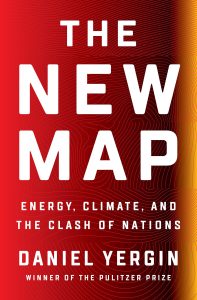By Pooya Hoseinpoori, Research Assistant, SGI
The global energy landscape has changed dramatically over the last decade. Three macro trends have reshaped the energy market and the global energy map over the past decade: the shale boom in the US, the growing role of renewable energy, and the rise of climate policies and government funding. Daniel Yergin, a veteran energy analyst, explores the new energy maps emerging from these changes in his latest book, “The New Map, Energy, Climate, and the Clash of Nations”. The global energy map has changed significantly since Mr Yergin published “The Quest” in 2011. In the New MAP, he updates and expands his analysis of technological advances, energy and geopolitical changes and presents a compelling narrative of developments that have disrupted the energy world over the past decade. 
The New Map opens with the new US map and the shale revolution, which raised the supply and lowered the price of oil and gas, and reshaped traditional oil and gas relations and geopolitics by changing the US’s position on the global energy market. Next is Russia’s map shaped by geopolitical competition and conflicts over unresolved borders from the collapse of the Soviet Union as well as a pivot to the east strategy and alliance with China. Then there is the new China map with its massive, ambitious international investment strategy known as the Belt and Road Initiative and its strategic plans for securing its commodity trade flows across the South China Sea. The Middle east’s map comes next in the book, formed by frontiers and rivalries and an economy highly dependent on oil and gas revenues. Last is the roadmap of the future and the climate maps discussing how the transition to a low carbon energy system might play out.
Like his previous books, the New MAP is full of detailed stories and interesting statistics about changes and events that formed these new maps: “By 2019 the unconventional revolution (shale boom) was supporting over 2.8 million jobs in the US”, “The US trade deficit in 2019 was 309 billion lower than it would have been if there was no shale revolution”, “China is building eight new airports a year”, “In 2019, $25 million cars were sold in China”, “Between 2006 and 2013 China’s gas consumption tripled” and also stories on Russia’s pivoting to east strategy and the new level of cooperation between China and Russia: “At the same time president Putin and president Xi were making pancakes together, their military joined in a large war game in the Far East”, “Chinese would provide the financing for a massive new $45 billion power of Siberia gas pipeline”, “Russia’s $25 billion investment on ESPO oil pipeline facilitated by $80 billion prepayment China made to Rosneft for deliveries over the next twenty five years”. Through all these statistics and stories, Mr Yergin sets the context for his contention that oil and gas will continue to be part of the ongoing energy mix, and their role remains a central theme of global energy order in the upcoming decades.
Yergin does not doubt climate change or question the transition to green energy. In his book, he discusses the substantial progress made in renewable energy and suggests that the use of wind and solar power will continue to grow despite the obstacles still standing in their way. He also provides a thorough history of the electric car (which I really enjoyed) and suggests that EVs will become commonplace and that governments will impose greater restrictions on fossil fuel use to combat climate change. He acknowledges that a change like this will eventually occur. But he believes that energy transformation is a gradual process that will take a very long time, and he is unconvinced that this will occur at the ambitious rates promised by net-zero targets. In his opinion, climate change concerns are not yet strong enough to majorly alter geopolitical orders or reshape development plans.
The New Map has been met with mixed reactions and responses, with the majority of critiques being directed at Yergin’s stance on energy transition. While some criticised him for being “so embedded in old patterns of thought that he can’t quite recognise the urgency of the climate crisis”, in the eyes of some, “he is injecting reality into expectations of the energy transition”. I share Yergin’s doubts about optimistic transition rates and very ambitious net-zero targets. My critique, however, goes to other chapters in which I found his perspectives US-centric and also primarily focused on oil and gas producing countries, with China being the only big demand centre discussed. I was hoping to read more about developing countries and new MAPs for Africa, India, or South America. Overall though, in my opinion, the New Map is timely and a fitting follow-up to his previous books “The Quest” and “The Prize”.
Ref 1) https://eandt.theiet.org/content/articles/2020/10/book-review-the-new-map-by-daniel-yergin/
Ref 2) https://www.independent.co.uk/arts-entertainment/books/daniel-yergin-bill-mckibben-new-map-book-review-energy-oil-climate-crisis-b672002.html
Ref 3) https://www.pressreader.com/usa/usa-today internationaledition/20200917/281848646024355
Ref 4) https://www.youtube.com/watch?v=Ye1EIY2p-wo
Ref 5) “The New Map, Energy, Climate, and the Clash of Nations”, Daniel Yergin, Penguin Press 2020


 ‘A nuanced overview of successes, barriers and lessons learned from the American shale gas revolution.’
‘A nuanced overview of successes, barriers and lessons learned from the American shale gas revolution.’